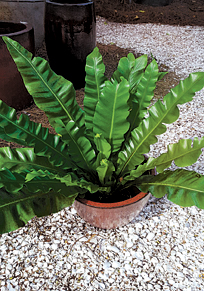Bird’s nest fern (Asplenium nidus), from the polypodiaceae family, is a plant straight from the rainforests of tropical Asia, that thrives in low light conditions and moist environments. In fact, too much light or direct light will cause this fern to yellow and wither, making this a perfect plant for inside or in any shady area of the yard.
This fern is an epiphyte, which means it can grow in very little soil. Ideally, it can be grown in moist, loose soil in the ground or attached to a tree or rock with just a small amount of planting medium. Attaching this fern to a fibrous slab and wiring to a tree trunk with copper wire, or planted in a pretty pot, this fern lends tropical flair to any indoor or shaded area.
Bird’s nest fern is named for the way the interior leaves slowly unfurl from the center. The entire shape of the fern loosely resembles the shape of a bird’s nest. It has wide shiny leaves with ruffled edges in a beautiful shade of bright green. This fern can reach a height of 2-4 feet and be about as wide, but does grow slowly.
Like many ferns, this plant is not drought tolerant and likes consistently moist soil, but not overly saturated. Fertilizer should only be applied a couple times a year with a water soluble fertilizer mixed at half strength. Do not pour fertilizer into the center of the plant, but rather around the outside in the soil. Too much fertilizer can cause discoloration and deformed leaves.
These ferns go naturally well with orchids, bromeliads and other moisture loving, low light plants. If you have an area that is shaded, try a bird’s nest fern and maybe some orchids for instant tropical rainforest look or plant one in a pretty pot as a dramatic specimen.
This column is a joint effort by all at In The Garden, Sanibel’s local garden center located at 3889 Sanibel Captiva Road, Sanibel Island, Florida.
